
![]()
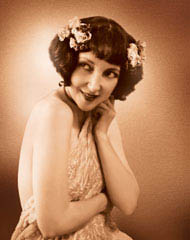
Janet Klein's BIOGRAPHY
Written by Stewart Mason
With her sleek bob haircut (usually with a flower placed just so), vintage fashion sense, strikingly beautiful looks and artfully customized ukulele, Janet Klein might seem at first to be a simple novelty act, a 21st-century hipster "ironically" recreating the subtly naughty looks of a fin-de-siecle French postcard. Then she opens her mouth to sing. There's no Betty Boop hiccups or Mae West-style brassiness in her charmingly original voice. And when she starts to play her ukulele, it's clear that this oft-ridiculed cousin of the guitar is neither prop nor gimmick, but a delightful and under-utilized musical instrument. Bearing an ever-expanding repertoire of, as she puts it, "obscure, lovely and naughty songs from the 1910's , 20's and 30's," Janet Klein is a musical archeologist hiding in the body of an F. Scott Fitzgerald heroine.
Raised in San Bernardino, California, during the 1970s, Klein's early musical education came from her father Stephen Klein, a teacher and avant-garde animator whose taste ran primarily to Frank Zappa and Classical. Even more importantly, Klein's grandparents regaled her with tales of New York in the 1930s (where her grandfather Marty Klein had worked as a stage magician), instilling a lifelong fascination with pre-World War II American popular culture into the young girl.
By the time Klein moved to Los Angeles to start college in the early '80s, this had translated into an interest in both early jazz recordings and the graphic designs styles of the era. Through the former, Klein discovered early female jazz singers and musicians like, Lil Hardin Armstrong (Louis' wife and early manager) and Blanche Calloway (sister of Cab). The latter hobby led Klein to start collecting sheet music from the 1800s to the Jazz Age, at first purely for the pictures and artwork, then increasingly out of love for the songs themselves.
Around this time, Klein met Robert Loveless, a local post-punk musician (Savage Republic, 17 Pygmies,etc.) who shared her love for early 20th century art and design and encouraged her artistic pursuits. Although Klein was becoming progressively more intrigued with her favorite style of music, she felt at the time that nobody would want to hear her sing, especially not the vintage pre-rock pop and early jazz tunes she loved. Instead, she channeled her creative energies into poetry and painting ( she self-published a chapbook of poems and drawings, When They Kiss I Leave, in 1989) as well as performance art. This changed when Klein discovered the Letter Exchange, a sort of pre-Internet chat room where folks left letters (remember letters?) on any number of topics to be published in small journals, to be read and responded to by others.
Through the Letter Exchange, Klein discovered that she wasn't alone in her dedication to such a supposedly unfashionable style. Encouraged, Klein picked up the ukulele, and as she mastered the instrument, she began to incorporate some of her favorite old songs into her poetry readings. Klein's breathy voice was perfectly suited to material from the teens and '20s, and by 1996, she dropped the poetry aspect of her performances entirely, concentrating on performing her favorite old songs in an authentic and straightforward style, staying true to the original material while entirely avoiding any whiff of kitsch or nostalgia.
Klein's straightforward vocal style places the lyrics foremost, so that the songwriters' clever construction and witty rhymes can be best appreciated. Indeed, her debut album, 1998's Come Into My Parlor, is almost a solo record, with Klein's vocals and ukulele occasionally unobtrusively supported by John Reynold's Django Reinhardt-style guitar and producer Loveless' accordion, mandolin, harmonica and triangle.
After that album was recorded, Klein started putting together a band to perform with. The Parlor Boys is a loose-knit conglomeration that can include up to a dozen musicians but usually tops out around six or seven. Reynolds (the grandson of '30s comic/sound and silent movie actress Zasu Pitts) remains, accompanied by two charter members of Robert Crumb's '70s trad-jazz group the Cheap Suit Serenaders, Robert Armstrong (Hawaiian steel guitar, accordion and musical saw) and Tom Marion (guitar, mandolin and banjo), plus musical historian Brad Kay (piano and cornet) and musicologist, author, radio personality and former British Invasion teen idol Ian Whitcomb (ukulele and accordion).
Klein's second album, Paradise Wobble (like the first bedecked in vintage photos and perfect replications of early 20th century graphic design), was credited to Janet Klein and her Parlor Boys. the wide-ranging disc earns the communal credit, featuring several Hawaiian-flavored instrumentals showcasing Armstrong as well as a delightful Whitcomb lead vocal on the profoundly odd "Tain't No Sin To Take Off Your Skin and Dance Around In Your Bones," a 1930 obscurity with a title that later turned up in a William S. Burroughs poem.
"I'm on a mission for charm," Klein states unapologetically. Everything she does, both professionally and personally, is done with an eye for beauty, wit, and indeed charm. Her current activities include recording new work for CD number six. Joined by her band,as well as special guests, Janet draws from rare material originally recorded by the likes of Wilton Crawley (little known clarinetist and vaudeville contortionist of the 1920's)and Robert Cloud (a highly quirky composer from Florida who had several of his works recorded by the Ross Deluxe Synchopators in a tobacco warehouse in 1927 by the Victor Recording Company). Other unusual tunes for the new record will include a little known Cole Porter song entitled "I'm Getting Myself Ready for You" and "Nakasete Chodai" or as titled in English, "Please Cry Me" a 1930s Japanese blues song. As usual, the group is cooking up some wild and wooly renditions of their own.
She continues to perform with her band mostly in Los Angeles but also makes appearances frequently in the San Francisco area (notably February 4, 2007, opening for R. Crumb's Cheap Suit Serenaders at the Freight and Salvage in Berkeley), as well as touring Japan regularly since 2002. Janet & the Boys have given concerts in numerous American movie palaces and other historic venues such as the grand Ahwahnee Hotel in Yosemite and can be found jazzing it up at their regular monthly shows at the Steve Allen Theater, Los Angeles. (www.steveallentheater.com) Janet also continues to utilize her collection of vintage photographic matter in graphic design projects including two miniature books "Love is A Boomerang" and "Take A Picture of the Moon" and has plans for a dvd of musical film shorts and live concert footage.
Official Site
www.janetklein.com/
![]()
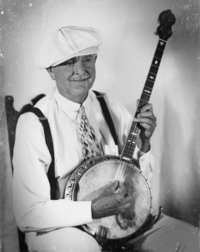
Photo by Jason Kaplan
Makeup and Hairstyling by Rumi Yamaguchi
John Reynolds picked up the banjo at the age of 11 and played it throughout high school in various dixieland and jug band groups. His focus shifted to the guitar after he heard Eddie Lang on the 1926 Jean Goldkette recording of "Sunday." His enthusiasm for the instrument reached new heights when he discovered the recordings of Django Reinhardt. He studied with George Smith (of the Paramount Studio Orchestra; Eddie Lang's sub when Bing Crosby needed an accompanist). Reynolds has played with Johnny Crawford’s 1920’s style orchestra, Dean Mora’s Modern Rythmists, Rhythm Club Allstars, and with his brother Ralf in the Rhythm Rascals. He is the grandson of the early Hollywood star and character actress, ZaSu Pitts.
John paints the bizarre landscape and people at the California and Hollywood jazz age beside his music works.
Fine Art America
fineartamerica.com/profiles/3-john-reynolds.html
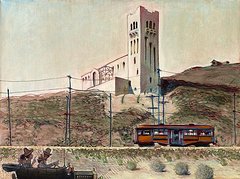
Highland Park 1914 (C) John Reynolds
![]()
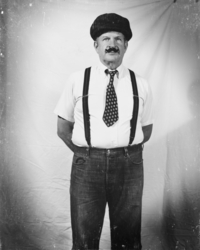
Photo by Jason Kaplan
Randy was born in Hollywood to a somewhat musical family. His mother was one of the Earl Carroll girls and had a singing trio (The Tailor Maids) which performed in nightclubs and movies ("Cowboy Canteen" - Columbia 1943 with Tex Ritter and the Mills Bros. - "So's Your Uncle"- 1943 Universal with Billie Burke, (they sang Gershwin's "Liza" with Jack Teagarden's Orchestra) - "Artistry In Rhythm" - 1944 with Stan Kenton - plus other soundies). His father played the drums in amateur bands in the '30's and in England during the war. In 1955 Randy's dad was one of the founders of the Society of Photographic Instrumentation Engineers (S.P.I.E.) which is now a world-wide organization. His older brother Paul, (who played with Tom Marion and Robert Armstrong in the Cheap Suit Serenaders) lives in the Seattle area and plays bass and alto sax with the Uptown Lowdown Jazz Band. He is easily one of the finest '20's style sax players in the world!
Randy started on the piano at age seven; and at age 12 he took drum lessons and then organ lessons at age 14. These have been his three main instruments since. After moving to Orange County in 1964, he was caught up in the British Invasion of the time and his older sister Gina was a member of the Ian Whitcomb Fan Club. With his sister and bewildered mother, Randy saw Ian in concert at the Melodyland Theatre in Anaheim (with Chad and Jeremy) in 1965. During high school, he played either drums or piano in the Happy Jazz Band of Newport Beach. In 1969, they were the featured band at Knott's Berry Farm. At about this time Randy heard the LP Bing Crosby In Hollywood album with the King of Jazz tracks and was forever hooked on that period in music. Randy won the John Phillip Sousa Band Award in his senior year and in 1971, he hired a young Ralf and John Reynolds to play in the orchestra for "The Boyfriend" at the Laguna Playhouse.
During the '70's and '80's he played in top-40, disco and big bands and later for many musical theatre shows. In the '80s he also played the timpani and orchestral percussion for several different orchestras, writing his Fantasy Allegro for Timpani and Orchestra and the Concerto for Orchestra and Piano. In 1986-87, he attended the USC Film Scoring program and hooked up with several L.A. studio musicians to form Rising Winds - a chamber ensemble of original music. Some of the musicians included Phil Feather, Vince Trombetta Sr., John Swan, John Mitchell, Tom Pedrini, etc.
Randy was heavily "lost" in classical-contemporary music until out of the blue who should call but TV star/crooner Johnny Crawford. Eleven years later Randy is still with the eccentric but lovable band which allowed him to re-hook up with John Reynolds, Tom Marion, Benny, Danny Weinstein, etc. Then, he was tapped to play with Janet Klein who for some reason liked his vibraphone playing. After the previous drummer (the eccentric but lovable George Edwards) moved to Japan, Randy has been playing more and more with Janet which is an unmatched experience like no other! He greatly admires the talents of everyone in the group and considers it an honor to be a part of it (even if it resembles the Mad Hatter Tea Party!) In the '90's, Randy went back to school and completed a Bachelors in Music Composition from Chapman University, and in 2005, received his Masters in Organ Performance from Azusa Pacific University. Randy plays an authentic 1931-style drum set that he built from parts. He also plays with Dean Mora's Modern Rhythmists, Mike Henebry's Crazy Rhythm Hot Society and Ian Whitcomb's Bungalow Boys. He also has been a regular church organist since 1970.
![]()
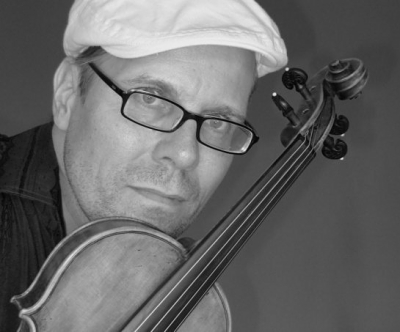
Benny Brydern studied violin and piano at the Richard-Strauss Academy of Music in Munich. He was invited to the Schleswig-Holstein Music Festival to perform in the Festival Orchestra under the baton of Leonard Bernstein in 1988. He returned to the Festival in 1990 for the TV series "Orchestra!" hosted by Sir Georg Solti and Dudley Moore. Benedikt composed the music for Jon Voight's Award-winning film "The Tin Soldier", the Miramax Documentary "Rhyme & Reason" and several other films.
He frequently performs with Janet Klein & Her Parlor Boys, Dean Mora Modern Rhythmists and other vintage ensembles.
Official Site
http://www.JazzViolin.us
http://www.ViolinPassion.com







